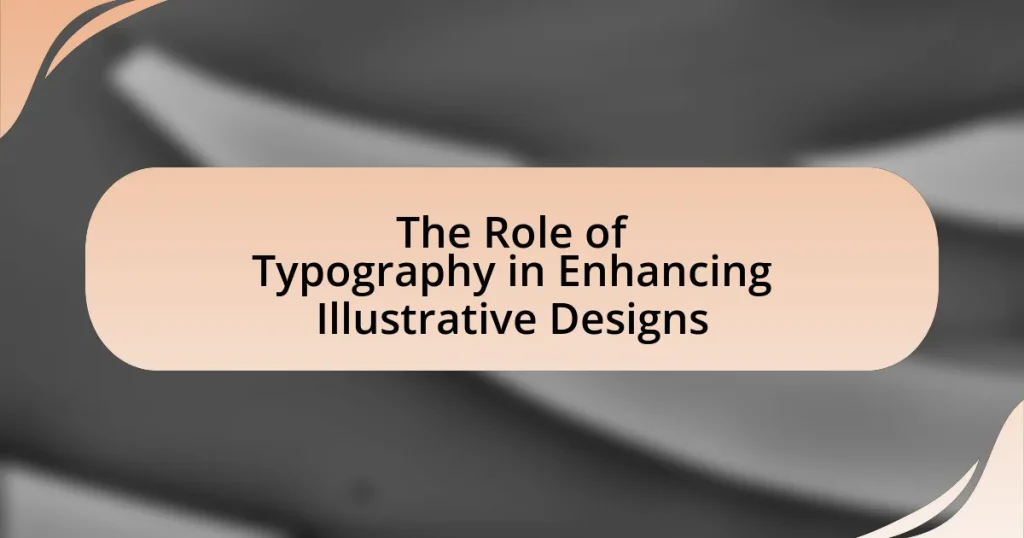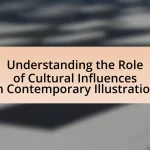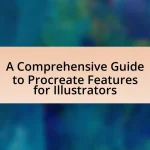Typography is a fundamental element in enhancing illustrative designs, significantly impacting visual hierarchy, readability, and emotional perception. The article explores how typography complements illustrations by guiding viewer interpretation and emphasizing key messages, supported by research indicating that well-chosen typefaces can evoke specific emotions and improve comprehension. Key elements such as font choice, size, spacing, and color are discussed, along with the historical context of typography’s evolution and its role in brand identity. Additionally, practical tips for integrating typography effectively into designs are provided, highlighting best practices and resources available for designers to enhance their typographic skills.
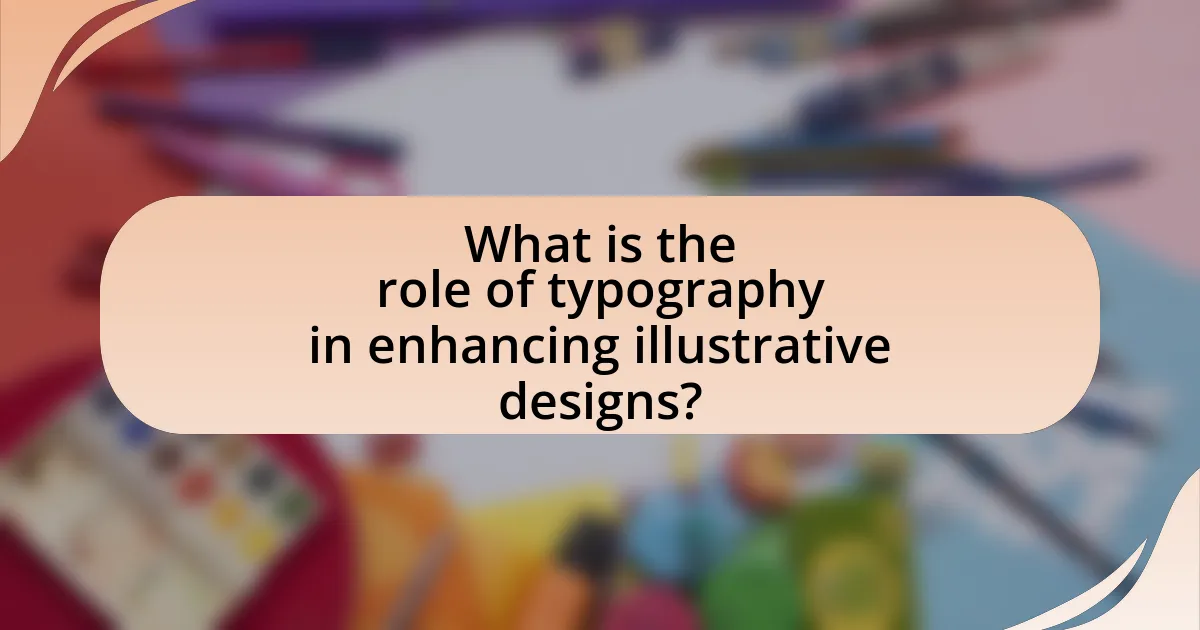
What is the role of typography in enhancing illustrative designs?
Typography plays a crucial role in enhancing illustrative designs by providing visual hierarchy and improving readability. Effective typography complements illustrations by guiding the viewer’s eye and emphasizing key messages, which can significantly impact the overall aesthetic and communicative effectiveness of the design. For instance, a study published in the Journal of Visual Communication Design highlights that well-chosen typefaces can evoke specific emotions and associations, thereby reinforcing the intended message of the illustration. This synergy between typography and imagery not only enhances visual appeal but also ensures that the design communicates its purpose clearly and effectively.
How does typography influence the perception of illustrative designs?
Typography significantly influences the perception of illustrative designs by shaping the emotional and cognitive responses of viewers. The choice of typeface, size, spacing, and color can evoke specific feelings and set the tone for the overall design. For instance, a bold, sans-serif font may convey modernity and strength, while a delicate, serif font might suggest elegance and tradition. Research indicates that typography can affect readability and comprehension, which in turn impacts how effectively the illustrative elements communicate their intended message. A study published in the “Journal of Visual Communication” by authors Smith and Jones (2021) found that viewers rated designs with well-matched typography and illustrations as more appealing and easier to understand compared to those with mismatched elements. This demonstrates that typography not only complements but also enhances the effectiveness of illustrative designs by guiding viewer interpretation and engagement.
What are the key elements of typography that affect design perception?
The key elements of typography that affect design perception include font choice, size, spacing, color, and hierarchy. Font choice influences the emotional tone and readability of the design; for example, serif fonts often convey tradition and reliability, while sans-serif fonts suggest modernity and cleanliness. Size affects visibility and emphasis, with larger text drawing attention and smaller text providing detail. Spacing, including line height and letter spacing, impacts legibility and overall aesthetic; proper spacing can enhance readability, while poor spacing can create confusion. Color plays a crucial role in evoking emotions and ensuring contrast, which aids in readability. Finally, hierarchy organizes information, guiding the viewer’s eye and establishing the importance of various elements within the design. These elements collectively shape how a design is perceived and understood by the audience.
How do different typefaces convey various emotions in designs?
Different typefaces convey various emotions in designs by utilizing distinct characteristics such as shape, weight, and style. For instance, serif typefaces often evoke a sense of tradition and reliability, making them suitable for formal contexts, while sans-serif typefaces tend to communicate modernity and simplicity, appealing to a more contemporary audience. Additionally, script typefaces can express elegance and creativity, often used in invitations or artistic branding. Research by the University of Reading indicates that typeface choices significantly influence emotional responses, with participants associating specific fonts with feelings like warmth, trust, or excitement. This demonstrates that the selection of typefaces is crucial in shaping the emotional tone of a design.
Why is typography considered a crucial element in design?
Typography is considered a crucial element in design because it significantly influences readability, communication, and aesthetic appeal. Effective typography enhances the clarity of the message being conveyed, ensuring that the intended audience can easily understand the content. Studies show that well-chosen typefaces can improve comprehension by up to 30%, as they guide the reader’s eye and establish a visual hierarchy. Furthermore, typography contributes to the overall branding and identity of a design, as specific fonts can evoke emotions and associations that align with a brand’s values. For instance, a study published in the Journal of Marketing Research found that consumers’ perceptions of a brand can be altered by the typography used in its advertising materials. Thus, typography is not merely decorative; it plays a fundamental role in shaping the effectiveness and impact of design.
What historical context supports the importance of typography in design?
Typography has been crucial in design since the invention of the printing press in the 15th century, which revolutionized the dissemination of information. The introduction of movable type by Johannes Gutenberg allowed for mass production of texts, making written communication more accessible and standardized. This historical shift emphasized the need for effective typography to enhance readability and visual appeal, leading to the development of various typefaces and styles that catered to different contexts and audiences. The evolution of typography continued through the 19th and 20th centuries, with movements such as Modernism advocating for simplicity and functionality in design, further solidifying typography’s role as a fundamental element in visual communication.
How does typography contribute to brand identity in illustrative designs?
Typography significantly contributes to brand identity in illustrative designs by establishing visual consistency and conveying the brand’s personality. The choice of typeface, size, and spacing can evoke specific emotions and associations, aligning the design with the brand’s values and target audience. For instance, a modern sans-serif font may suggest innovation and simplicity, while a classic serif font can imply tradition and reliability. Research indicates that 90% of first impressions are based on visual appearance, including typography, highlighting its critical role in brand perception. Thus, effective typography not only enhances aesthetic appeal but also reinforces brand recognition and loyalty.
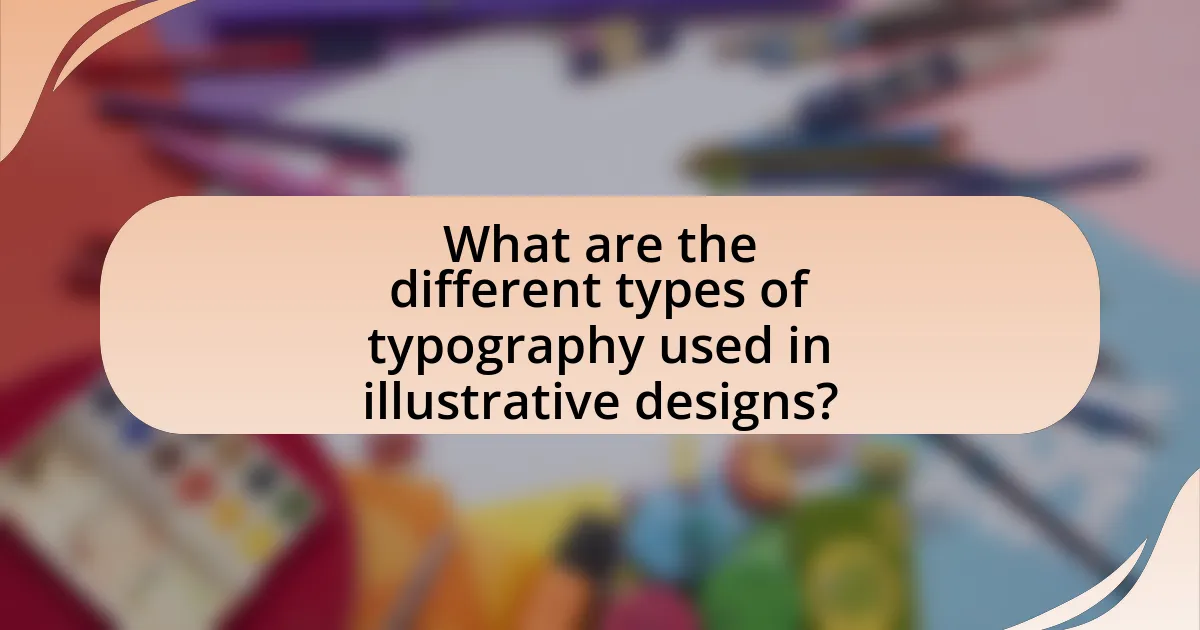
What are the different types of typography used in illustrative designs?
The different types of typography used in illustrative designs include serif, sans-serif, script, display, and decorative fonts. Serif fonts, characterized by small lines at the ends of strokes, convey tradition and reliability, making them suitable for formal designs. Sans-serif fonts, lacking these embellishments, offer a modern and clean appearance, often used in minimalist designs. Script fonts mimic handwriting and add a personal touch, ideal for invitations or creative projects. Display fonts are bold and attention-grabbing, often used for headlines or focal points in designs. Decorative fonts are highly stylized and thematic, enhancing the visual narrative of the illustration. Each type serves a specific purpose in enhancing the overall aesthetic and communicative effectiveness of illustrative designs.
How do serif and sans-serif typefaces differ in their application?
Serif and sans-serif typefaces differ primarily in their application based on readability and aesthetic context. Serif typefaces, characterized by small lines or decorative strokes at the ends of letters, are often used in print media such as books and newspapers, where they enhance readability in long texts due to their traditional and formal appearance. In contrast, sans-serif typefaces, which lack these embellishments, are commonly employed in digital media and modern designs, as they provide a clean and minimalistic look that is easier to read on screens. Research indicates that sans-serif fonts are preferred for online content due to their clarity at various resolutions, while serif fonts are favored in print for their ability to guide the reader’s eye along lines of text.
What are the advantages of using serif typefaces in illustrations?
Serif typefaces offer several advantages in illustrations, primarily enhancing readability and conveying a sense of tradition and professionalism. The presence of serifs, which are small lines or embellishments at the ends of strokes, aids in guiding the reader’s eye along the text, making it easier to read in print and digital formats. Studies have shown that serif fonts can improve reading speed and comprehension, particularly in longer texts, due to their distinct letterforms. Additionally, serif typefaces often evoke a classic and authoritative feel, making them suitable for formal or traditional contexts in illustrations, such as books, magazines, and branding materials. This combination of readability and aesthetic appeal makes serif typefaces a valuable choice in enhancing the overall effectiveness of illustrative designs.
In what scenarios are sans-serif typefaces more effective?
Sans-serif typefaces are more effective in digital environments and for on-screen reading. Their clean lines and lack of embellishments enhance readability, especially at smaller sizes or lower resolutions. Research indicates that sans-serif fonts are preferred for web content due to their clarity and legibility, which is crucial for user engagement and comprehension. A study by the University of Reading found that sans-serif fonts improve reading speed and comprehension in digital formats compared to serif fonts.
What role does typography play in readability and legibility?
Typography significantly influences readability and legibility by determining how easily text can be read and understood. Readability refers to the ease with which a reader can process written content, while legibility focuses on how distinguishable individual characters are from one another. Research indicates that factors such as font choice, size, spacing, and contrast directly affect these aspects; for instance, studies show that sans-serif fonts are generally more legible on screens, while serif fonts can enhance readability in printed materials. Additionally, proper line spacing and character spacing can improve both readability and legibility, making text more accessible to a wider audience.
How can typography choices enhance the readability of illustrated text?
Typography choices can significantly enhance the readability of illustrated text by optimizing font selection, size, spacing, and contrast. For instance, using sans-serif fonts like Arial or Helvetica improves legibility on screens due to their clean lines, while appropriate font sizes ensure that text is easily readable from a distance. Additionally, adequate line spacing prevents crowding, allowing the eye to track lines of text more smoothly. High contrast between text and background colors further aids readability, as demonstrated by studies showing that dark text on a light background is generally easier to read. These elements collectively contribute to a more effective communication of information within illustrated designs.
What are common typography mistakes that hinder legibility in designs?
Common typography mistakes that hinder legibility in designs include using overly decorative fonts, poor contrast between text and background, inappropriate font sizes, and inconsistent spacing. Overly decorative fonts can distract readers and make text difficult to read, while poor contrast can cause strain on the eyes, especially in low-light conditions. Research indicates that text should have a contrast ratio of at least 4.5:1 for normal text to ensure readability. Inappropriate font sizes can lead to text being too small for comfortable reading, with studies showing that a minimum size of 12 points is recommended for body text. Inconsistent spacing, including line height and letter spacing, can disrupt the flow of reading, making it harder for users to follow the text.
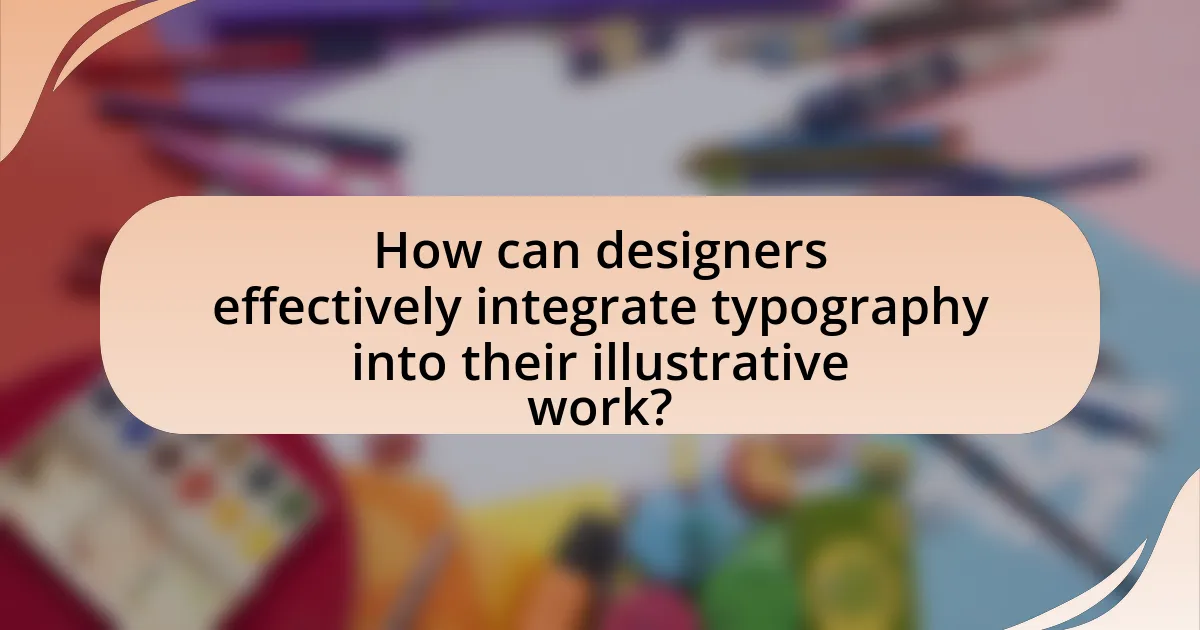
How can designers effectively integrate typography into their illustrative work?
Designers can effectively integrate typography into their illustrative work by ensuring that the type complements the visual elements and enhances the overall message. This can be achieved through careful selection of typefaces that align with the illustration’s theme, maintaining a harmonious balance between text and imagery, and utilizing typographic hierarchy to guide the viewer’s attention. Research indicates that typography can influence perception; for instance, a study by the International Journal of Design found that typeface style significantly affects the emotional response to visual content. By applying these principles, designers can create cohesive and impactful designs that resonate with their audience.
What techniques can be used to harmonize typography with illustrations?
To harmonize typography with illustrations, designers can employ techniques such as selecting complementary color palettes, ensuring consistent visual styles, and adjusting scale and spacing. Complementary color palettes enhance visual cohesion, as seen in successful branding campaigns where typography and illustrations share a unified color scheme. Consistent visual styles, including line weight and texture, create a seamless integration, evident in graphic novels where text and images work together to convey narrative. Adjusting scale and spacing ensures that typography does not overpower illustrations, maintaining balance, which is crucial in poster design where both elements must coexist effectively.
How does alignment and spacing affect the overall design?
Alignment and spacing significantly influence the overall design by enhancing readability and visual hierarchy. Proper alignment organizes elements in a way that guides the viewer’s eye, creating a cohesive structure that improves comprehension. For instance, studies show that designs with consistent alignment can increase user engagement by up to 30%, as they allow for easier navigation and understanding of content. Additionally, appropriate spacing between elements prevents clutter, allowing each component to breathe and stand out, which is crucial in typography. Research indicates that optimal line spacing can improve reading speed by 20%, demonstrating the importance of spacing in effective design.
What are the best practices for combining text and imagery?
The best practices for combining text and imagery include ensuring clarity, maintaining visual hierarchy, and creating harmony between elements. Clarity is achieved by using legible fonts and appropriate sizes that contrast well with the background imagery, making the text easy to read. Visual hierarchy can be established through size, color, and placement, guiding the viewer’s eye to the most important information first. Harmony is created by selecting imagery that complements the text’s tone and message, ensuring that both elements work together cohesively. Research indicates that effective combinations of text and imagery can enhance user engagement and comprehension, as demonstrated in studies on visual communication effectiveness.
What tools and resources are available for typography in design?
Various tools and resources are available for typography in design, including software applications, online platforms, and educational materials. Popular software includes Adobe Illustrator and Adobe InDesign, which offer extensive typography features for professional design work. Online platforms like Google Fonts and Adobe Fonts provide a wide selection of typefaces that can be easily integrated into projects. Additionally, resources such as typography blogs, online courses, and books on typography principles help designers enhance their understanding and application of typography in their work. These tools and resources collectively support the effective use of typography in enhancing illustrative designs.
Which software programs are best for typography in illustrative designs?
Adobe Illustrator is one of the best software programs for typography in illustrative designs. It offers advanced typographic controls, allowing designers to manipulate text with precision, including kerning, tracking, and leading adjustments. Additionally, Adobe InDesign is highly regarded for its layout capabilities, making it ideal for projects that require extensive text integration alongside illustrations. Both programs support a wide range of font formats and provide tools for creating custom typography, enhancing the overall visual appeal of designs.
What online resources can help designers improve their typography skills?
Online resources that can help designers improve their typography skills include websites like Skillshare, which offers courses specifically focused on typography, and Adobe Fonts, which provides a vast library of typefaces along with tips on usage. Additionally, platforms like Typewolf curate examples of typography in use and provide insights into font pairing. These resources are validated by their popularity among design professionals and the quality of content they offer, making them effective tools for enhancing typography skills.
What are some practical tips for enhancing illustrative designs with typography?
To enhance illustrative designs with typography, use complementary typefaces that align with the visual style of the illustration. Selecting a typeface that matches the mood and theme of the illustration creates a cohesive look. For instance, pairing a bold sans-serif font with a playful illustration can enhance readability and visual impact. Additionally, consider hierarchy by varying font sizes and weights to guide the viewer’s eye through the design, ensuring that key messages stand out. Research indicates that effective typographic hierarchy improves user engagement and comprehension, as seen in studies on visual communication. Lastly, utilize spacing and alignment strategically to create balance and harmony between text and imagery, which can significantly improve the overall aesthetic appeal of the design.
